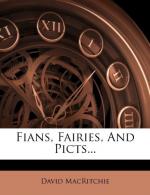“That some of the myths of giants and dwarfs are connected with traditions of real indigenous or hostile tribes is settled beyond question by the evidence brought forward by Grimm, Nilsson, and Hanusch,” observes Dr. E.B. Tylor.[10] And although that eminent anthropologist sees a different meaning in many kindred traditions, yet his observations, and the great mass of references which he gives in connection with this single detail, are of much interest to euhemerists pure and simple. The late Sir Daniel Wilson’s “Caliban"[11] teems with the realistic doctrine, and so also does a work of (in my opinion) less equal merit, “The Pedigree of the Devil,"[12] by Mr. Frederic T. Hall. In Mr. R.G. Haliburton’s “Dwarfs of Mount Atlas: with notes as to Dwarfs and Dwarf Worship,"[13] and also in his “Further Notes"[14] on that subject, the same idea is prominent. All of these writers, with the exception of Sir Thomas Browne (and excluding Dr. Tylor in so far as regards some of his deductions), refer practically, though in varying degrees, to the question discussed by Tyson; and in this respect I must also cite my recent work on “The Ainos” (pp. 51-66). Of other writers who have not probed quite so deeply, and who possibly may not recognise the necessity for so doing, but who are realists nevertheless, the following may be mentioned: M. Paul Monceaux, who, in the Revue Historique of October 1891, deals with the African dwarfs of ancient and modern writers;[15] Professor Henri van Elven, the main theme of whose forthcoming work, Les Nains prehistoriques de l’Europe Occidentale, formed the subject of a paper recently read by him before the Societe d’Archeologie de Bruxelles; and MM. Grandgagnage and De Reul, cited by Mr. C. Carter Blake, F.G.S., in connection with the Nutons of the Belgian bone-caves;[16] as also another writer of the Low Countries, Van den Bergh ("xxx. and 313"), whom Mr. J. Dirks quotes at p. 15 of his Heidens of Egyptiers, Utrecht, 1850. In Mr. W.G. Black’s charming book on Heligoland,[17] one passage (p. 72) recognises that a certain Sylt tradition “is evidently one of those valuable legends which illuminate dark pages of history. It clearly bears testimony to the same small race having inhabited Friesland in times which we trace in the caves of the Neolithic age, and of which the Esquimaux are the only survivors.” For many of the kindred traditions in that locality, one cannot do better than refer to Mr. Christian Jensen’s Zwergsagen aus Nordfriesland, contributed to the Zeitschrift des Vereins fuer Volkskunde (Berlin, Heft 4, 1892).




